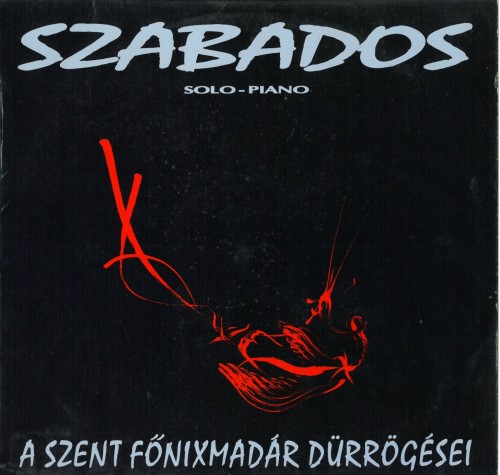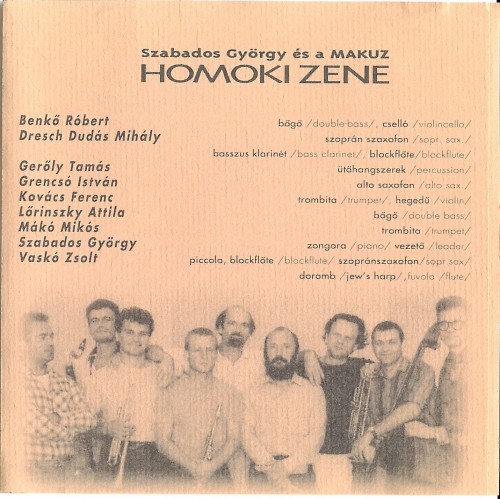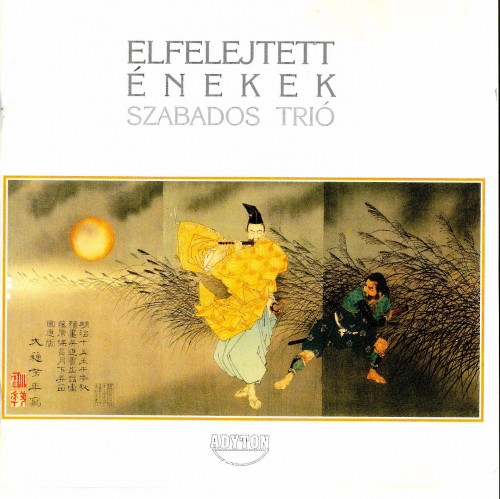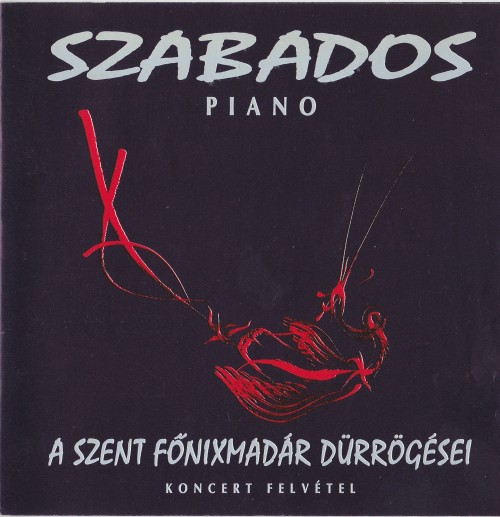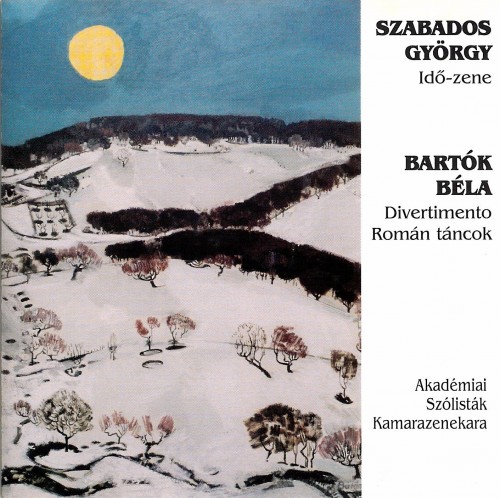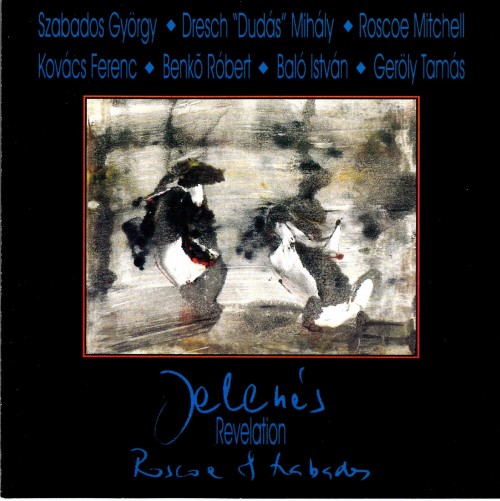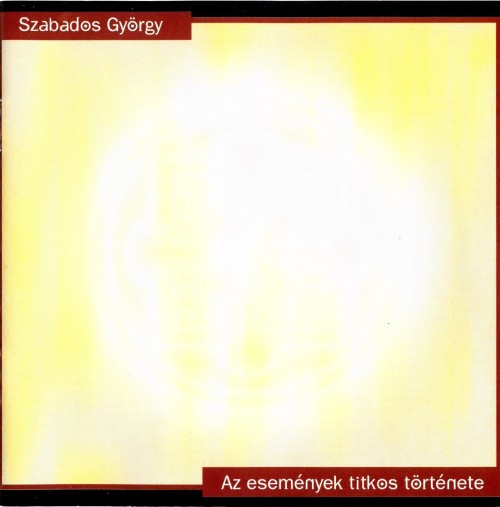1991:
Ruttings of the Sacred Phoenix Bird – A szent főnixmadár dürrögései (1990) – Adyton 004
LINER NOTES: 
To Bicskei Zoltan
The Phoenix, mysterios bird of all cultures, first burns and dies to ashes, it sacrifies itself, so that in this racking fire it can be reborn from ist own will in the form of heavently embers, evber more splendit. Sacred bird, the non-existend bird of eternity, bird that never was, yet the most real and most beautiful: a phenomenon of the imagination and the heart, it represents the dominiom of Life’s mystery cover the pettiness of Fate. It is a symbol, the dazzling symbol of rebirth and the earthly and heavenly pleasure of eternity. That accepts this curios, sacrificial role with wisdom: it is not afraid, it does not break, it does not revolt. It is an initiate. It is this bird that flutters in every moment of every deed, that roots in every autumn and every sunset, and it is this bird that hovers over the suffiocatting smoke of indignities – one that is not a murderer among nest-builders. Stir, sacred bird, be resurrected in the fire of our sooty love, sing out through our burnt vocal cords, dance in the faithful tunnels of our fire-brand bones.
Let you blessed death-trance shine. Be gentle to all those speaking beautifully to you in this sea of muck. Beautifully, to the bird of Heaven.
November 1991
György Szabados
1991:
Sands Music / Homoki Zene (1991) – Adyton 005
LINER NOTES: 
While recording this album at the Gallery of Contemporary Paintings in Szombathely, we were visited by a party of gods whom we received in an obedient trance:
“They descended on our hearts They, our beloved birds.”
Our land is the Puszta, the dry seabed, the plains of sand exposed to the sky. In the holy dawn, a mysterious flock of gods suddenly emerge over fields among the poplars and plume their feathers while the glaring sun traces its heavenly course, gilding the leafy corners of silence.
“Then they fly away with a flapping of wings.”
To see, call and touch this secret Eden, the soul had to be faithful and discrete, the heart naturally open, and the notes had to be freely but perfectly controlled.
While entirely improvised, the music has its roots in the vast sandy expanse of eastren Hungary, blends national with Europian music and reflects the history of our half of the continent. It comes from a love of the Puszta and a steady heart.
Sand Music is dedicated to the spirit of the Puszta. Mingled in it are identity and play, fate and memory, a reverie close to heaven and earth. A reeaching into ourselves and out for the timeless Universe.
Poetry, moments of magic, Zen. Blissful music dedicated to the great Kindred Spirits.
Credit to the musicians who made it.
September 1991 György Szabados
1996
Forgotten Songs / Elfelejtett énekek (1994) – Fonó Records FA 12-01
LINER NOTES: 
You hear the fig-bird singing
There is silence these days around genuine great music. Deepest silence.
It is increasingly rare to get a chance to listen to live, creative, real music. You must be initiated, a member of a secret association to know the imprints of the small number of hidden musical pieces which are difficult to find. The flute players were compelled to withdraw to dense reedy marshes. The aggressive bagman lords the site.
read more....The musical-ideological soil calling itself musical world today, with its institutional system will continue to neglect, by-pass for some more time to come such new music, which indeed growth from seed. A dying civilisation preserving the status-quo has been Ming to extend its existence, by attaching itself to illusions. The supported frame has been empty for quite some while. It contains nothing the heart would like to hear.
But elsewhere there is something. Signs of a more complete world spark from under the hills of ashes. A never heard complexity. a music of extremely varied shades and rhythms arise from the music of the trio and from most of similar compositions — as if it was the pulsation of magma. Approaching it from the side of form one notes first the pulsation. then the taste and depth, fierce dynamism of the sound are noticed. The space of music, the quality of existence regain their shaping-retaining force. The new quality of solos and harmonies the free community, released from the old shackles suggest the emergence of some other world.
Musicians able to hear in an accelerated age preparing for its end have stopped to listen inwardly with the archaic rythm of their newly emerging capacity to improvise, helping — similarly to singing birds — the birth of a new world embalmed yet kt tong forgotten songs the musicians surmise. No matter how complex the purity. organic articulation of the initiating music “Forgotten Songs”, its internal momentum radiates simpleness and wealth, which could not be there without thousands of years of rich cultural traditions.
A new language would be needed to describe and analyse of the height and beauty of the music of Szabados with the eternal peace of deep silence, a music, which is ahead of its time. Although a new ethos has already been developed in Hungarian and the language is also prepared for it, the musical marl is still missing. The creative musician creating everything anew is here, the one who feels at home in the musical world. Szabados himself spells out his human-artistic credo: “…. to find one’s place and oneself through great improvisation, the cosmic fever of love, to become one with Everything, conclude the deal with the divines.”
Zoltán Bicskei
1997:
Ruttings of the Sacred Phoenix Bird – A szent főnixmadár dürrögései (1991) – Szabados es Tsa. Kkt. – Szerzöi kiadas
LINER NOTES: 
To Bicskei Zoltan
The Phoenix, mysterios bird of all cultures, first burns and dies to ashes, it sacrifies itself, so that in this racking fire it can be reborn from ist own will in the form of heavently embers, evber more splendit. Sacred bird, the non-existend bird of eternity, bird that never was, yet the most real and most beautiful: a phenomenon of the imagination and the heart, it represents the dominiom of Life’s mystery cover the pettiness of Fate. It is a symbol, the dazzling symbol of rebirth and the earthly and heavenly pleasure of eternity. That accepts this curios, sacrificial role with wisdom: it is not afraid, it does not break, it does not revolt. It is an initiate. It is this bird that flutters in every moment of every deed, that roots in every autumn and every sunset, and it is this bird that hovers over the suffiocatting smoke of indignities – one that is not a murderer among nest-builders. Stir, sacred bird, be resurrected in the fire of our sooty love, sing out through our burnt vocal cords, dance in the faithful tunnels of our fire-brand bones.
Let you blessed death-trance shine. Be gentle to all those speaking beautifully to you in this sea of muck. Beautifully, to the bird of Heaven.
November 1991
György Szabados
1997:
György Szabados: Time-Music (Idő-zene) & Bartók Béla: Divertimento & Román népi táncok (Rumanian Folk Dances) (1997) – Fonó Records FA-034-2
LINER NOTES: 
I wrote Time-Music in the fall of 1980, making some minor changes on it in 81 and 85. The music known today as repetitive, confronted repetition, with repeating elementary figures. The occurance of repetition – as opposed to what others composers did – here is not merely a mechanic monotone, instead I approach it in its entirety.
read more....György Szabados (1987)
ACADEMY SOLOISTS
The Academy Soloists Orchestra was founded in 1995 by talented graduates of the famous Franz Liszt Academy of Music, Budapest. The musical director is Vilmos Szabadi, international violin soloist.
read more....– Flesh Violin Competition 1-st prize
– Zathureczky Violin Competition 2-nd prize, special prize
– Weiner Chamber music competition 1-st prize
– Lukács Viola competition 2-nd prize
– Koncz Violin competition -special prize
They chose to complete their individual activities by intensive team work in this ensemble. During its fairly short existence, the orchestra has already given sussesful concerts. They have also been inveted to several European countries, such as Switzerland and Finland. The repertoire of the ensamble ranges from Baroque to contemporary music.
“The Divertimento was Bartók’s last composition in Europe, before his emigration.
read more....The piano cycle entitled Rumanian fblk Dances written in 1915 was followed two years later by Bartók’s orchestral transcription. Two additional orchestral versions were written during the 1920’s – one by Arthur Willner for string orchestra and another by A. Wilke for salon ensemble. The orchestral adaptation succeeded in preserving the classic, enclosed world of miniature arrangements which were based on Rumanian instrumental folklore even within the framework of a larger apparatus. The dances each less than a minute’s duration in a fashion that is reminiscent of the Baroque suite. Each dance is sounded by a different ensemble of instruments. The movements follow one another attacca and the gradual broadening of the various ensembles serves to enhance the homogeneous construction of the work.”
Forrás / Origin by: ÚJFALUSSY Józef
1998:
Revelation / Jelenés – György Szabados / Roscoe Mitchell (1996) – Fonó Records FA-038-2
LINER NOTES: 
In the fall of 1994, Roscoe Mitchell heard MAKUZ and sent the message that our music had made an impression on him and he would be happy to accept an invitation to play with us. In 1996 this became an actuality, even after being unable to fulfill a contract in 1995, because of a lack of funding.
read more....The concert was on October 7th,1996 in Budapest’s Thália Theatre. The concert was a fantastically successful, extraordinary event, an almost holy atmosphere was created. Thanks to the skilled work of Fonó Music Hall, this recording can be released.
“Don’t cry, don’t cry, don’t cry,
Saint Stephen our king.
We are not the devil,
We are your servants.”
So you see, this recording is Makuz’s (the school of Makuz) creative presence, and born of the musicality of a distressed world.
March 1998, György Szabados
(translated by Sue Foy)
1999:
CD1: The Secret History of the Events / Az események titkos története (1996)
CD2: The Sons Turned into Stags / A szarvassá vált fiak (1985) – Fonó Records FA-068-2
LINER NOTES: 
Behind all art we find man, torn between Heaven and Earth, but also
giving life to being. In the grand and sacred workings called Cosmos we
must all live through to the end the mystery of release and bondage, the
mystery of the freedom of existence beyond self and history.
read more....
There is no world and art separate. When language and music fall apart everything falls apart,but in the mute iconostasis everything comes together in unity. Sometimes heavenly light reveals itself, then man becomes pure and beautiful, the community good and united, and worldly power then is amazed. And an inaudible chord is struck. This event is called freedom,and it is at times like this that freedom can be really understood.To live under the sign of freedom is a struggle. This is the background of the two compositions on this disc, music of a sacral inspiration. The place is the heart of Europe, the time the second half of the
20th century, its world the homelessness of despotism, its hope: the irrefutable truth. The matter of art is to tell stories – for the sake of souls
– about the condition of the Soul.
The revolution and freedom fight of 1956 has hardly inspired any componist yet to my knowledge. The Secret History of the Events was born in 1983, in my improvisatory style, on the basis of my own text. In the era of communism, when saying the truth, when respect for the human soul became all but impossible, and a cult of trash and violence was maintained by the state, this music attempted, through the expressive declamation of an enigmatic text, to tell the story of the trampling down of freedom in 1956. In a 20th century incarnation of the minstrel songs of the Renaissance, it was an act of defiance, telling, against all prohibitions, that honour was being kept alive. This is the task of the sound of the piano, “prepared”, manipulated, “banned”, and of the similarly “prepared libretto, a meta-language: to tell a story that could not be openly told, accompanied by the heart-tones of wood wind instruments resounding through time and space.
The composition has been performed only three times, in 1984, 1986 and 1996. Under the effect of the historical turning point of 1990, Ire-translated the last two stanzas of the libretto from meta-language into actual speech. All the other musical solutions, and the improvisatory style, true to the Kafkaesque ambiguity of our age, have been left untouched.
The 1996 performance we hear on this disc is marked by the unique incantatory art of Tams Kobzos Kiss, and the richly emotional, confessional style of instrumentalists like Mihäly Dudäs Dresch and Zsolt Vaskö.
The Sons Turned Into Stags, a composition in four movements, is an interior story. The dramatic conflict of mother and son, of community and person, of the abandoned paradise and human isolation, and their resolution. Because, from the beginning, the idyll – Heaven – the memory of the pre-natal, drives us, and sends us its promises. This is what gives meaning, what gives us the force to live through our fate of freedom, leading us through the mush and mass of of imperfection.
This composition was commissioned by Ivän Markö for the Györ Ballet Theatre in 1983, and the premiere performance took place at the Szeged Open Air Festival of 1984. The dance play was composed and choreographed especially for the excellent Makuz Orchestra. In Markö’s concept, with my full agreement, the performance became an apotheosis of the 1956 revolution, which caused no little consternation among the censors. As a result, the play was banned for many years. The apotheosis comes at the end, when the massacred sons, having died a hero’s death, and returning into the spirit-arms of their mothers, turn into redeemed heavenly stags-as a vindication of the sacred spirit of 1956, and my own personal vindication.
I am grateful that these two compositions have come into existence,
and are published together now on this occasion.
Györy Szabados (1999)
(English translation by Gyula Kodolänyi)
